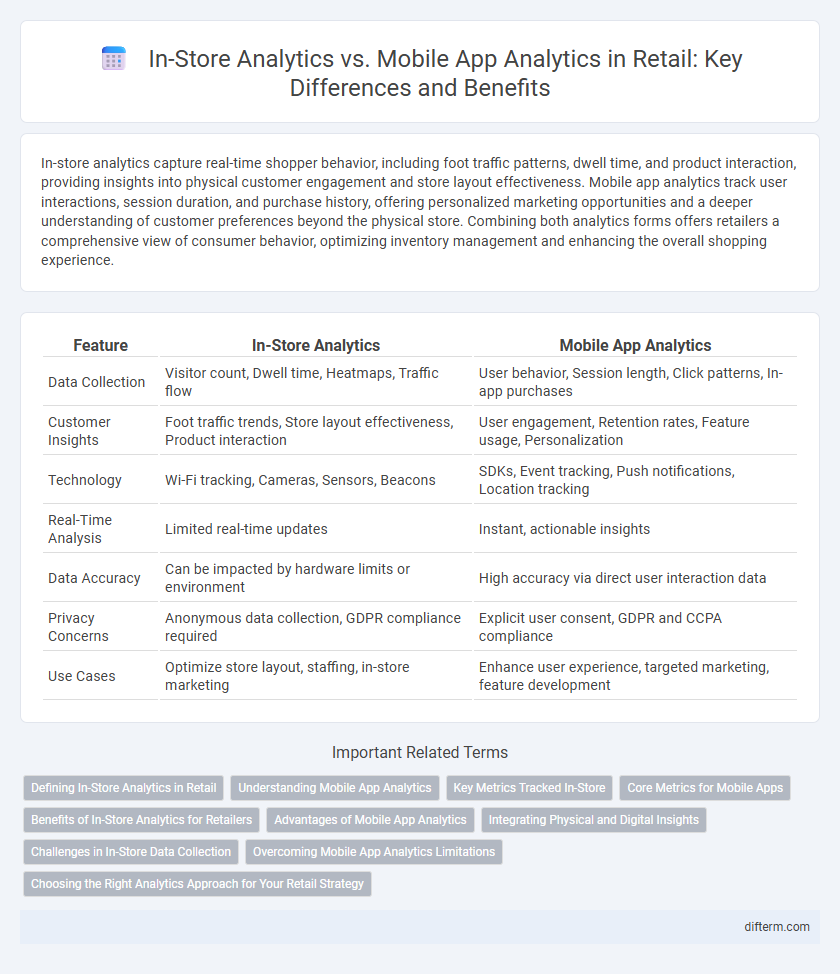In-store analytics capture real-time shopper behavior, including foot traffic patterns, dwell time, and product interaction, providing insights into physical customer engagement and store layout effectiveness. Mobile app analytics track user interactions, session duration, and purchase history, offering personalized marketing opportunities and a deeper understanding of customer preferences beyond the physical store. Combining both analytics forms offers retailers a comprehensive view of consumer behavior, optimizing inventory management and enhancing the overall shopping experience.
Table of Comparison
| Feature | In-Store Analytics | Mobile App Analytics |
|---|---|---|
| Data Collection | Visitor count, Dwell time, Heatmaps, Traffic flow | User behavior, Session length, Click patterns, In-app purchases |
| Customer Insights | Foot traffic trends, Store layout effectiveness, Product interaction | User engagement, Retention rates, Feature usage, Personalization |
| Technology | Wi-Fi tracking, Cameras, Sensors, Beacons | SDKs, Event tracking, Push notifications, Location tracking |
| Real-Time Analysis | Limited real-time updates | Instant, actionable insights |
| Data Accuracy | Can be impacted by hardware limits or environment | High accuracy via direct user interaction data |
| Privacy Concerns | Anonymous data collection, GDPR compliance required | Explicit user consent, GDPR and CCPA compliance |
| Use Cases | Optimize store layout, staffing, in-store marketing | Enhance user experience, targeted marketing, feature development |
Defining In-Store Analytics in Retail
In-store analytics in retail involves collecting and analyzing data from physical store environments to understand customer behavior, optimize store layouts, and enhance the shopping experience. This includes tracking foot traffic, dwell time, and product interactions through technologies like sensors, cameras, and beacons. In contrast to mobile app analytics, which focus on digital interactions, in-store analytics provides actionable insights grounded in real-world shopper behavior within the retail space.
Understanding Mobile App Analytics
Mobile app analytics provide detailed insights into user behavior, engagement patterns, and purchasing trends within a retail app, enabling personalized marketing and improved customer experience. By tracking metrics such as session duration, click-through rates, and conversion funnels, retailers can optimize app features and promotions to boost sales. Unlike in-store analytics, mobile app analytics capture real-time data across diverse touchpoints, offering a comprehensive view of digital customer interactions.
Key Metrics Tracked In-Store
In-store analytics primarily track foot traffic, dwell time, conversion rates, and customer behavior patterns within the physical retail space to optimize layout and staffing. Metrics such as heat maps, queue lengths, and product interaction rates provide insights into shopper engagement and operational efficiency. These data points enable retailers to enhance the in-store experience, improve merchandising strategies, and increase sales performance.
Core Metrics for Mobile Apps
Core metrics for mobile app analytics in retail include user engagement, retention rate, session duration, and conversion rate, offering detailed insights into shopper behavior within the app environment. In-store analytics primarily focus on foot traffic, dwell time, and product interaction, which measure physical customer activity and store layout effectiveness. Mobile app metrics provide granular data on personalized marketing impact and purchase pathways, enabling retailers to optimize digital touchpoints and enhance the omni-channel experience.
Benefits of In-Store Analytics for Retailers
In-store analytics empower retailers by providing real-time insights into customer behavior, foot traffic patterns, and product interactions, enabling optimized store layouts and personalized marketing. These data-driven strategies enhance customer engagement, increase conversion rates, and improve inventory management accuracy. Real-time analysis of in-store metrics creates a competitive advantage by addressing immediate operational inefficiencies and elevating the overall shopping experience.
Advantages of Mobile App Analytics
Mobile app analytics provides real-time data on customer behavior, enabling retailers to personalize marketing campaigns and enhance user engagement effectively. It offers comprehensive insights into in-app navigation, purchase patterns, and customer preferences that are difficult to capture through in-store analytics alone. The ability to track mobile app interactions across multiple locations and devices helps retailers optimize the customer journey and increase conversion rates.
Integrating Physical and Digital Insights
In-store analytics capture shopper behavior through foot traffic patterns, dwell times, and product interactions, while mobile app analytics provide data on user engagement, preferences, and purchase history. Integrating these datasets creates a unified view of customer journeys, enabling personalized marketing strategies and inventory optimization. Retailers leveraging combined insights improve decision-making, increase conversion rates, and enhance overall shopping experience across both physical and digital channels.
Challenges in In-Store Data Collection
In-store analytics face significant challenges due to physical environment constraints such as limited sensor placements, varying lighting conditions, and privacy concerns affecting customer tracking accuracy. Unlike mobile app analytics, which capture detailed user interactions and behavioral data seamlessly, in-store data collection struggles with incomplete or inconsistent datasets caused by hardware limitations and manual observation errors. Ensuring real-time analytics in physical retail spaces demands sophisticated integration of IoT devices and advanced data processing to overcome noise and maintain actionable insights.
Overcoming Mobile App Analytics Limitations
In-store analytics provide precise tracking of customer behavior through sensors and cameras, capturing real-time foot traffic and dwell times that mobile app analytics cannot fully replicate due to device variability and privacy constraints. Integrating beacon technology and Wi-Fi analytics bridges data gaps by linking physical movement to mobile activity, offering a comprehensive view of customer engagement across channels. Overcoming mobile app analytics limitations requires combining location-based insights with in-store data to enhance personalization and optimize retail strategies.
Choosing the Right Analytics Approach for Your Retail Strategy
In-store analytics capture customer behavior through sensors, cameras, and electronic shelf labels, providing real-time insights into foot traffic, dwell time, and product interactions that optimize store layout and inventory. Mobile app analytics track user engagement, purchase patterns, and preferences within your app, enabling personalized marketing and seamless omnichannel experiences. Selecting the right approach depends on your retail strategy goals: choose in-store analytics to enhance physical shopping experiences and mobile app analytics to drive digital customer engagement and loyalty.
In-Store Analytics vs Mobile App Analytics Infographic

 difterm.com
difterm.com